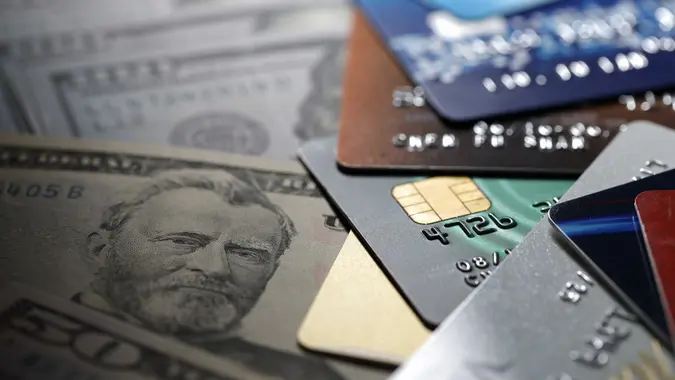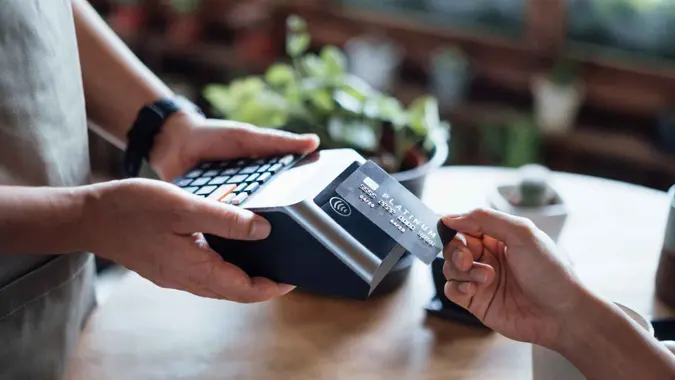5 Things To Do if Your Bank Refuses To Cancel Your Credit Card After Fraud

Commitment to Our Readers
GOBankingRates' editorial team is committed to bringing you unbiased reviews and information. We use data-driven methodologies to evaluate financial products and services - our reviews and ratings are not influenced by advertisers. You can read more about our editorial guidelines and our products and services review methodology.

20 Years
Helping You Live Richer

Reviewed
by Experts

Trusted by
Millions of Readers
When 85-year-old Joel Weiss* of Boca Raton, Florida, opened his Citibank statement, he was alarmed to see recent charges he did not recognize — among them, a $3,000 retail expenditure in Indiana, King Kong DVDs, and several untraceable Amazon purchases. Not only had he not bought anything from Amazon in 2024, be he also didn’t know anyone in Indiana. Suspecting fraud, Weiss called his bank to cancel his credit card and, in effect, close his account. That was two months ago — meanwhile, his account remains open while suspicious charges accrue.
“I have spoken to at least five to six customer service and fraud agents at Citi. It has been a very frustrating experience,” stated his son, Matthew Weiss,* who has been assisting his father.
After his father’s initial call to Citibank, Weiss’ card was frozen and he was issued a replacement card in the mail. This made his previous card inactive, but it did not stop recurring charges to his account. “For the alleged customer’s convenience and to avoid disrupting legitimate services, [banks] allow recurring charges if the customer account is in good standing,” stated Yashin Manraj, CEO of Pvotal Technologies. Yet, not all recurring charges were his.
“Merchants and credit card processors launched an ‘updater’ mechanism or active matching account system to limit payment disruptions when a card expires or is replaced,” stated Manraj. “Unfortunately, in some instances, closed, frozen and locked cards allow merchants to receive the new information without the user’s or bank’s knowledge and allow fraud to continue.”
So why is the bank still refusing to cancel the card?
“The bank may want to keep the account open temporarily to investigate the fraudulent transactions,” stated Alexander Hall, trust and safety architect at Sift. “Closing the card too soon may hamper their ability to track or dispute unauthorized charges,” and could, therefore, impact the refund process.
Yet, Citibank made headlines in January when New York’s attorney general, Letitia James, sued the institution for failing to protect fraud victims. The major accusation? Citibank’s “failure to reimburse.”
Since the process of getting your card cancelled post-fraud charges may sound quite daunting and exhausting giving the example above, GOBankingRates spoke with experts to learn five moves you can make to protect yourself if the bank refuses to cancel your card after fraud.
1. File a Fraud Alert
When it comes to fraud, vigilance is important. Chris Borkenhagen, chief information security officer at AuthenticID, advised filing a fraud alert with one of the major credit bureaus: Equifax, Experian or Transunion. While this won’t cancel your card, it could help deter bad actors from opening another line of credit in your name or making changes to your accounts for one full year. According to Transunion, “a fraud alert is free and notifies creditors to take extra steps to verify your identity before extending credit.”
2. Place Security Freeze on Your Credit Report
“Freezing your credit can help protect against identity theft and fraud [by limiting access to your] credit report without your permission,” according to Experian. A security freeze is more restrictive than a fraud alert, and lasts until you remove it. This becomes especially important to do if you think your Social Security number may have been compromised.
3. Reduce Your Credit Card Limit to $1
Manraj offered a clever workaround if the bank won’t close your card: in rare cases, consumers have been able to successfully reduce their credit card limit to just $1 in order to prevent any further fraudulent charges. You can request the deduction by contacting your card issuer, but be advised that doing so can hurt your credit score by increasing your credit utilization rate.
4. File Formal Complaint with the FBI or CFPB
“If the issue persists, consumers should consider escalating the issue by filing a formal complaint with the Federal Bureau of Investigation (FBI) or the Consumer Financial Protection Bureau (CFPB),” stated Borkenhagen. “The CFPB can prompt an investigation into the issue, holding banks accountable for their actions and encouraging them to take consumer concerns seriously.” This is often the most successful route in promptly getting the bank to cancel a card.
5. Present Death Certificate or Valid Power of Attorney
In cases where a victim of fraud suddenly dies or becomes incapacitated, canceling their card obviously gets easier, right? Not necessarilu. “In [these] cases, most family or friends face significant challenges in getting any fraud case or account closure, and the result highly depends on the eagerness of the support agent,” stated Manraj. He advised, however, that most banks do have policies for allowing those with death certificates or valid power of attorney to cancel the card.
*Disclaimer: To protect anonymity, Joel and Matthew Weiss are pseudonyms.
More From GOBankingRates
 Written by
Written by  Edited by
Edited by 
























